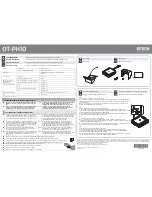
15-3
Catalyst 2975 Switch Software Configuration Guide
OL-19720-02
Chapter 15 Configuring VTP
Understanding VTP
If you configure a switch for VTP transparent mode, you can create and modify VLANs, but the changes
are not sent to other switches in the domain, and they affect only the individual switch. However,
configuration changes made when the switch is in this mode are saved in the switch running
configuration and can be saved to the switch startup configuration file.
For domain name and password configuration guidelines, see the
“VTP Configuration Guidelines”
VTP Modes
You can configure a supported switch stack to be in one of the VTP modes listed in
.
Table 15-1
VTP Modes
VTP Mode
Description
VTP server
In VTP server mode, you can create, modify, and delete VLANs, and specify other configuration
parameters (such as the VTP version) for the entire VTP domain. VTP servers advertise their VLAN
configurations to other switches in the same VTP domain and synchronize their VLAN configurations with
other switches based on advertisements received over trunk links.
VTP server is the default mode.
Note
In VTP server mode, VLAN configurations are saved in NVRAM. If the switch detects a failure
while writing a configuration to NVRAM, VTP mode automatically changes from server mode to
client mode. If this happens, the switch cannot be returned to VTP server mode until the NVRAM
is functioning.
VTP client
A VTP client behaves like a VTP server and transmits and receives VTP updates on its trunks, but you
cannot create, change, or delete VLANs on a VTP client. VLANs are configured on another switch in the
domain that is in server mode.
In VTP versions 1 and 2, in VTP client mode, VLAN configurations are not saved in NVRAM. In VTP
version 3, VLAN configurations are saved in NVRAM in client mode.
VTP transparent VTP transparent switches do not participate in VTP. A VTP transparent switch does not advertise its
VLAN configuration and does not synchronize its VLAN configuration based on received advertisements.
However, in VTP version 2 or version 3, transparent switches do forward VTP advertisements that they
receive from other switches through their trunk interfaces. You can create, modify, and delete VLANs on
a switch in VTP transparent mode.
In VTP versions 1 and 2, the switch must be in VTP transparent mode when you create extended-range
VLANs. VTP version 3 also supports creating extended-range VLANs in client or server mode. See the
“Configuring Extended-Range VLANs” section on page 13-10
.
When the switch is in VTP transparent mode, the VTP and VLAN configurations are saved in NVRAM,
but they are not advertised to other switches. In this mode, VTP mode and domain name are saved in the
switch running configuration, and you can save this information in the switch startup configuration file by
using the
copy running-config startup-config
privileged EXEC command. The running configuration and
the saved configuration are the same for all switches in a stack.
VTP off
A switch in VTP off mode functions in the same manner as a VTP transparent switch, except that it does
not forward VTP advertisements on trunks.
Содержание 2975 - Catalyst LAN Base Switch
Страница 36: ...Contents xxxvi Catalyst 2975 Switch Software Configuration Guide OL 19720 02 ...
Страница 40: ...xxxviii Catalyst 2975 Switch Software Configuration Guide OL 19720 02 Preface ...
Страница 62: ...1 22 Catalyst 2975 Switch Software Configuration Guide OL 19720 02 Chapter 1 Overview Where to Go Next ...
Страница 398: ...13 30 Catalyst 2975 Switch Software Configuration Guide OL 19720 02 Chapter 13 Configuring VLANs Configuring VMPS ...
Страница 424: ...15 18 Catalyst 2975 Switch Software Configuration Guide OL 19720 02 Chapter 15 Configuring VTP Monitoring VTP ...
Страница 628: ...26 8 Catalyst 2975 Switch Software Configuration Guide OL 19720 02 Chapter 26 Configuring UDLD Displaying UDLD Status ...
Страница 660: ...28 8 Catalyst 2975 Switch Software Configuration Guide OL 19720 02 Chapter 28 Configuring RMON Displaying RMON Status ...
Страница 888: ...38 32 Catalyst 2975 Switch Software Configuration Guide OL 19720 02 Chapter 38 Troubleshooting Troubleshooting Tables ...
















































